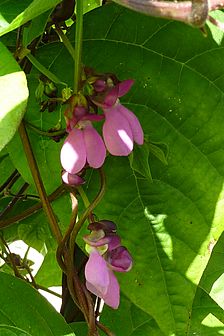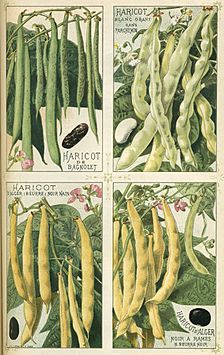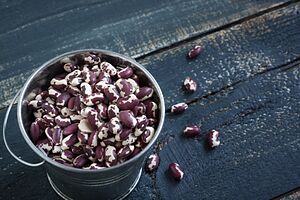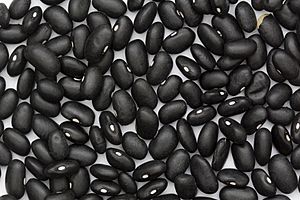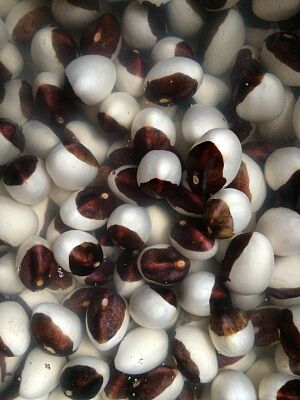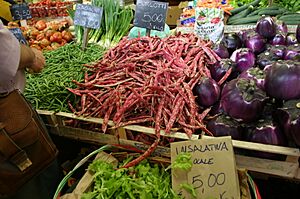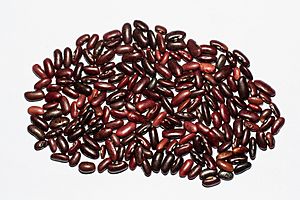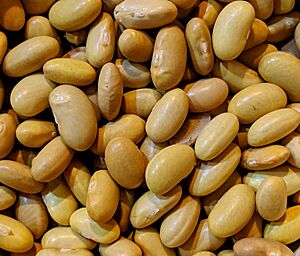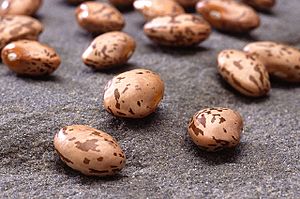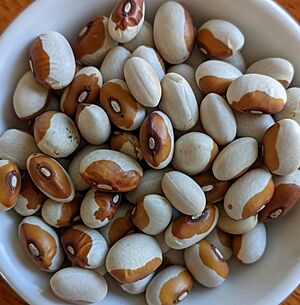Common bean facts for kids
Quick facts for kids Common bean |
|
|---|---|
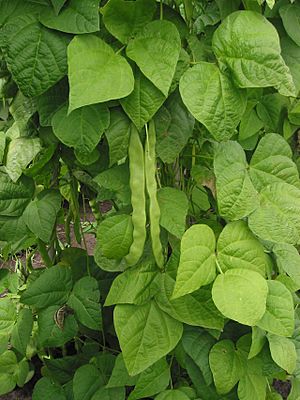 |
|
|
A flat-podded variety of the common bean
|
|
| Scientific classification | |
| Synonyms | |
|
The Phaseolus vulgaris, also known as the common bean or French bean, is a plant grown all over the world. People grow it for its seeds or its young fruit, which we call beans.
There are three main types of common beans. Dry beans are seeds harvested when they are fully grown. Snap beans are tender pods picked before the seeds are big. Shell beans are seeds taken out of their pods when they are ready to eat. Sometimes, the plant's leaves are eaten as a vegetable. The dried plant parts can also be used as fodder for animals.
The common bean is part of the legume family, called Fabaceae. Like most plants in this family, common beans get the nitrogen they need from tiny bacteria in the soil. These bacteria help the plant "fix" nitrogen from the air.
This bean species is very diverse and has been grown for a long time. Wild common beans grow like climbing vines. However, many types grown by farmers are either bush beans (which grow as small bushes) or pole beans (which climb). Famous types include the kidney bean, navy bean, pinto bean, and wax bean. Other important beans are the runner bean and the broad bean.
Beans are grown on every continent except Antarctica. In 2016, farmers grew 27 million tonnes of dried beans and 24 million tonnes of green beans worldwide. Myanmar was the top producer of dried beans. China grew 79% of all green beans.
Wild common beans come from the Americas. Scientists first thought they were grown by people in two different places: Mesoamerica and the southern Andes. But new studies show that beans were first grown in Mesoamerica. From there, they traveled south. They likely moved with other important crops like squash and maize (corn). These three crops were very important to Native American farming. They were known as the "Three Sisters".
Contents
What is a Common Bean?
The common bean is a very varied plant with a long history. Bush types grow as upright plants, about 20 to 60 centimeters (8 to 24 inches) tall. Pole or climbing types grow as long vines, reaching 2 to 3 meters (6.5 to 10 feet) long.
All types have green or purple leaves. Each leaf has three oval-shaped leaflets. These leaflets are smooth and measure about 6 to 15 cm (2.4 to 6 inches) long and 3 to 11 cm (1.2 to 4.3 inches) wide.
The flowers are white, pink, or purple and about 1 cm (0.4 inches) long. After the flowers, pods grow. These pods are 8 to 20 cm (3 to 8 inches) long and 1 to 1.5 cm (0.4 to 0.6 inches) wide. They can be green, yellow, black, or purple. Each pod holds 4 to 6 beans.
The beans themselves are smooth, plump, and shaped like a kidney. They can be up to 1.5 cm (0.6 inches) long. Their colors vary greatly and are often mottled with two or more colors. It's important to know that raw or undercooked beans have a natural protein that can make you sick. Always cook them well!
Dry Beans
Like other beans, common beans have a lot of starch, protein, and dietary fiber. They are also a great source of iron, potassium, selenium, and several B vitamins.
Dry beans can last a very long time if kept in a cool, dry place. But over time, their nutrients and flavor can lessen. They also take longer to cook. Dried beans are almost always cooked by boiling. People often soak them in water for several hours first. Soaking isn't strictly necessary, but it helps them cook faster and more evenly. It also removes some sugars that can cause gas for some people.
There are different ways to soak beans. You can soak them overnight. Or you can boil them for three minutes, then let them sit for 2 to 4 hours. Always drain and throw away the soaking water before cooking. Dry common beans take longer to cook than most other pulses. Cooking times can be from one to four hours. However, using a pressure cooker can make them cook much faster.
In Mexico, Central America, and South America, people often use a spice called epazote with beans. This spice is also said to help with digestion. In East Asia, a type of seaweed called kombu is added to beans while they cook for the same reason. Adding salt, sugar, or acidic foods like tomatoes to uncooked beans can make them harder. This means they will take a bit longer to cook.
You can also buy dry beans already cooked and canned. These might be refried beans or whole beans with water, salt, and sometimes sugar.
Green Beans and Wax Beans
The most common types of green beans are string or snap beans. These can have round or flat pods. Stringless or French beans do not have a tough, stringy fiber along the pod. Runner beans are a different species of bean. Green beans can sometimes have purple pods, which turn green when cooked.
Wax beans are common beans that have yellow or white pods. These types are often grown as bush beans.
As their name suggests, snap beans break easily with a clear "snap" sound when bent. The pods of snap beans (which can be green, yellow, or purple) are picked when they are growing fast. They should be fleshy, tender, and bright in color. The seeds inside should still be small. This is usually 8 to 10 days after the flowers bloom.
Compared to dry beans, green and wax beans have less starch and protein. But they have more vitamin A and vitamin C. Green beans and wax beans are often steamed, boiled, stir-fried, or baked in casseroles.
Shelling Beans
Shelling beans are beans that are taken out of their pods before you cook or dry them. Common beans can be used this way. But the term also includes other types of beans whose pods are not usually eaten. Examples are lima beans, soybeans, peas, and fava beans. Fresh shell beans are similar to dry beans in nutrients. However, they are cooked more like a vegetable. They are often steamed, fried, or made into soups.
Popping Beans
The nuña bean is a special type of common bean from the Andes mountains. Its seeds are round and have many colors, looking a bit like pigeon eggs. When these beans are cooked with high heat, they pop open. This is similar to how popcorn or other puffed grains explode.
Bean Types and Varieties
Some scientists think the common bean first came from Mesoamerica. There is still debate about whether beans were domesticated once or many times. Over time, two main groups of beans developed. One group is from the Andes mountains, from southern Peru to northwest Argentina. The other group is from Mesoamerica, between Mexico and Colombia.
Large bean seeds that were grown by people have been found in Peru. They date back to 2300 BC. These beans then spread to the coast by about 500 BC. Smaller bean seeds were found in Mexico from 300 BC. They later spread north and east of the Mississippi River by 1000 AD.
Many well-known bean types belong to this species. The list below shows some of them. Both bush and climbing (pole) types exist. The colors and shapes of the pods and seeds can be very different.
| Name | Image | Description |
|---|---|---|
| Anasazi | Anasazi beans are red and white beans. They were first grown by the Ancestral Puebloans around 130 CE in the Four Corners area of the United States. They became popular with farmers in the 1980s. Traditionally, they were called frijol conejo (rabbit bean), vaquita (little cow), or pajaro carpintero (woodpecker). | |
| Appaloosa | The front of this bean is ivory white. The other end has purple and mocha speckles. It is named after the Appaloosa ponies of the Nez Perce tribe. This bean was grown near the Palouse River in Eastern Washington and Northern Idaho. | |
| Black turtle | The black turtle bean has small, shiny black seeds. It is very popular in Latin American cooking. | |
| Calypso | Calypso beans are half black and half white. They have one or two black dots in the white part. When they are young, their pods can be eaten as green beans. But when fully grown, they are used as dried beans. | |
| Cranberry | Cranberry beans first came from Colombia and were called cargamanto beans. Borlotti or Roman beans are a type of cranberry bean grown in Italy. They have a thicker skin. They are used a lot in Mediterranean cooking. | |
| Dragon tongue | Dragon tongue beans are young green beans. They are flavorful and juicy. Their seeds are inside a colorful pod with burgundy patterns. The shelled beans are light green, small, and slightly curved. | |
| Flageolet | Flageolet beans are picked before they are fully ripe. They are dried in the shade to keep their green color and special taste. The seeds are small, light green, and kidney-shaped. They are firm but creamy if cooked when fresh or semi-dry. They are often eaten in France, usually with lamb. | |
| Kidney | Kidney beans are also called red beans. They are named because they look like a kidney. They are sometimes used in chili con carne. They are also a key part of cooking in northern India. In New Orleans and Louisiana, they are used for the Monday dish of red beans and rice. They are also used in Caribbean habichuelas guisadas and Central American gallo pinto. | |
| Pea | A type of common bean called pea bean has been in Britain since the 1500s. In the US, "pea bean" also means small white beans. The same name is used for Vigna unguiculata subsp. sesquipedalis, also called yard-long bean. The British pea bean seeds are red-brown and white. The plants are climbing beans. The beans can be eaten in the pod like French beans, or harvested when mature and eaten as dried beans. | |
| Peruano | Also known as mayacoba, canary, canario, Peruvian, or Mexican yellow bean. This is a light green to yellow kidney-shaped bean. It is popular in parts of Mexico for making frijoles refritos. It is also used for tacu tacu, a fried cake of leftover beans and rice. People often say it has a "buttery" and "creamy" texture. | |
| Pink | Pink beans are small, pale pink, oval-shaped beans. They are also known as habichuelas rosadas in Spanish. The Santa Maria pinquito bean is grown in Santa Maria, California. It is a key ingredient in Santa Maria-style barbecue. | |
| Pinto | Pinto beans are named for their mottled skin (pinto means painted or mottled in Spanish). They are the most common bean in the United States and northwestern Mexico. They are often eaten whole in broth or mashed as refried beans. Whole or mashed, they are a common filling for burritos. The young pods can also be picked and cooked as green pinto beans. | |
| Rattlesnake | A medium-sized, oblong bean with light brown seeds striped with brown marks. It is named because its pods coil around the vine like a snake. | |
| Sulphur | Also called China Yellow Bean. This is a thin-skinned, nearly round heirloom bean from Maine. It has a yellowish color but cooks white. It has a unique flavor. This bean is a good choice for traditional Bean Hole cooking. | |
| White | Navy beans or haricot beans are very popular in the United Kingdom and the United States. Other white beans include cannellini, a popular type in central and southern Italy. Cannellini beans are related to the kidney bean. White beans are the best plant source of phosphatidylserine. | |
| Yellow (Enola type) | 'Sinaloa Azufrado', 'Mayocoba', and 'Peruano' (also called canary) are types of yellow beans. Peruano beans (see above) are small, oval, yellow beans about 1 cm (0.4 inches) long with thin skin. They have a creamy texture when cooked. Even though their name means 'Peruvian beans' in Spanish, they are from Mexico. Yellow beans were uncommon in the United States because of a patent issued in 1999. This patent was for a yellow bean strain brought from Mexico. The patent was later rejected in 2008. | |
| Yellow Eye | Also called Maine Yellow Eye. This is the most popular baking bean in Maine. It comes in several types, including the 'Steuben,' which is one of the oldest heirloom beans. It is popular for its clean, mild taste. It is considered the best bean for church and grange suppers. | |
| Tongue of Fire | Tongue of Fire (also known as Horto) has ivory white pods with red streaks that look like flames. The bean stalks grow close together. They need a lot of sun and form large, roundish pods. The original seeds reportedly came from Tierra del Fuego in South America. They were sent to Italy and then spread through southern Europe. |
How Beans Are Grown
In 2016, the world produced 23.6 million tonnes of green beans. China grew 79% of this total. For dried beans, the world produced 26.8 million tonnes in 2016. Myanmar, India, and Brazil were the top producers.
|
|
|||||||||||||||||||||||||||||||||||
See also
 In Spanish: Phaseolus vulgaris para niños
In Spanish: Phaseolus vulgaris para niños


